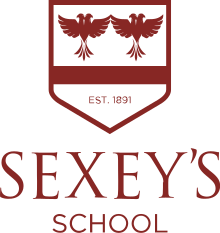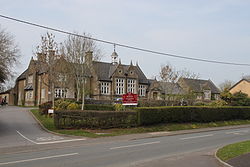Sexey's School
| Sexey's School | |
|---|---|
 | |
 | |
| Address | |
 | |
Cole Road , , BA10 0DF England | |
| Coordinates | 51°06′19″N 2°27′48″W / 51.1053°N 2.4632°W |
| Information | |
| Type | Academy Day and boarding school |
| Religious affiliation(s) | Church of England |
| Established | 1891 |
| Department for Education URN | 137313 Tables |
| Ofsted | Reports |
| Head teacher | Helen Cullen |
| Age | 11 to 18 |
| Enrolment | 551 pupils (as of 2013)[1] |
| Capacity | 602 |
| Colour(s) | Burgundy, gold and black |
| Website | www |
Sexey's School is a Church of England, co-educational state boarding and day school in Bruton, Somerset, England for 11-18 year olds. Sexey's School is named after Hugh Sexey who, in 1599, was appointed as a Royal auditor to Elizabeth I and later as a Royal auditor to James I. Sexey's Hospital was established in 1619 from the proceeds of his will, and the school was founded in 1889. State boarding schools are most unusual in England and Wales. The school became an academy in August 2011.
History[edit]
Sexey's School dates back to a trade school which opened on 6 April 1891 with 15 boys. The first Head Master was William Albert Knight.[2] The Head Master and the boys moved into temporary premises in a house known as 'The Glen' on Quaperlake Street in Bruton.[3] At the end of its first year there were 40 boys at the school learning basic subjects including practical mechanics, land measuring and elementary science.[4] The school was moved to its current site in 1892 in new buildings designed by Norwich-based architect George Skipper.[5] The new buildings were formally opened on 19 April 1892.[3]
As headmaster, William A. Knight emphasized science. His students include the outstanding British biologists, L. J. F. Brimble, Frederick Tom Brooks, Ralph Warren Marsh, and Walter Cecil Moore.[6]
Sexey's was a grammar school until the Education Act 1944, after which it became a Voluntary Controlled school. In 1991 it adopted Grant Maintained status and in September 1999 it became a Voluntary Aided school.[7]
It remained an all-boys school until 1977 when it became fully co-educational. Boarding facilities were expanded in the 1980s with the building of two new boarding houses – Lisbury House and Coombe House – making Sexey's one of the largest schools of its type in the country.[7] The school has continued expansion with the introduction of a policy in 2003 to take day pupils from a local catchment area of 1.5 miles. Prior to this the last day pupil was admitted in 1983. In 2001 the school had 394 pupils.[8] In 2007 there were 512 pupils.[9]
As a state boarding (and day) school, Sexey's has complex funding arrangements with both state (government funded) and independent income (for the boarding facilities).[10]
In 2013 the then Secretary of State for Education, Michael Gove, described Sexey's as "one of the most outstanding schools in the country," during an interview on the Andrew Marr Show on BBC One.[11]
In 2019 two catering managers were convicted of defrauding the school of over £16,000.[12]
In 2019, after a number of poor Ofsted results and on the recommendation of the Regional Schools Commissioner, the school considered merging into the Sherborne Area Schools' Trust multi-academy trust. But following extensive parental engagement by Sexey's parents, governors and government representatives who were in opposition to the move,[13] the Sherborne Trust decided not to proceed, stating there was "not an alignment of values or partnership working with Sexey's". The Regional Schools Commissioner considered what the next step should be.[14][13][15] Ofsted inspection visits in 2020 and 2021 found that leaders and those responsible for governance were taking effective remedial action.[16]
Boarding[edit]
Around one fifth of the school are boarders. There are two boarding houses:
- Macmillan House, Opened 2011, is a new £3.5 m installation replacing Walwin House. Its name is a tribute to Douglas MacMillan who was an old boy of the school (Old Sexeian) and founded MacMillan Cancer Support.
- Coombe House, opened 1983. Coombe has capacity for around 100 boarders in all year groups.
Former boarding houses include:
- Walwin House (formerly Junior House) was two houses built in the late 1930s. Walwin House used to accommodate year 7 boarders and had the capacity for 49 children – 30 boys and 19 girls.
- Cliff House, a Grade II listed building built by Thomas Hannam in 1820 opened as a boarding house in 1892. It used to takes boarders in all year groups but is now used for teaching and holiday lets.[17]
- Lisbury House, opened 1983, is currently undergoing renovation.
Headteachers[edit]
- William Albert Knight (1891–1927)
- Wallace E. Page (1927–1955)
- William R. Towns (1955–1965)
- Norman S. Roberts (1965–1970)
- David Curtis (1970–1980)
- John Lello (1980–1989)
- David Charman (1989–1995)
- Stephen Burgoyne (1995–2007)
- Raymond McGovern (2008–2013)
- Jean Hopegood (Acting Head) 2013
- Irfan Latif (2013–2017)
- Gill Kelly (Interim Head) (2017–2018)
- Helen Cullen (2018–
School song[edit]
The school song is a devotional chorus.[18]
Hear mighty Lord,
Thy Sexeian's humble cry:
Hear, mighty Lord.
Inspire with motives high
For work and School.
For students here and past
Grant thankfulness,
And endless rest at last.
2002 calendar[edit]
In 2001, a group of pupils produced a glossy calendar as part of a Young Enterprise business project, sold for charity, called "Sexey's Hot Twelve", that featured 12 pictures of boys and girls in seductive poses. Child protection groups criticised the calendar for its potential attraction to adults who prey on vulnerable young people. The school reported that they had received no complaints, and that most of the 500 copies were bought immediately after going on sale.[19][20]
Notable former pupils[edit]
- Craig Alcock, professional footballer[21]
- L. J. F. Brimble, botanist and editor of Nature magazine[22]
- Frederick Tom Brooks FRS, botanist, Professor of Botany, Cambridge University, attended 1895–1898[23]
- John Bryant, Journalist (Editor in Chief of the Telegraph titles) and marathon runner[24]
- Tim Burt, British geographer and Master of Hatfield College, Durham
- Gilbert Gabriel, musician and member of The Dream Academy[25]
- Lucy Giles, first female college commander at the Royal Military Academy Sandhurst[26]
- Brian Gomm, amateur cricketer and footballer
- Douglas Macmillan, founder of Macmillan Cancer Support.[27]
- Hubert Phillips, economist, broadcaster, journalist, author, bridge player and organiser
- Professor Sir David John Read FRS, biologist, Vice President and Biological Secretary of the Royal Society[28]
- Sir Harold Richard Scott, Commissioner of the Metropolitan Police, 1945–1953[29]
- Ned Sherrin, broadcaster, author and stage director, 1931–2007[30]
- Alex Tew, creator of Million Dollar Homepage[31]
- Nigel Vincent FBA, linguist and academic[32]
- Arthur Willis, botanist and editor[33]
Notable former staff[edit]
- Charles Edward Moss, botanist, science master at Sexey's in 1901[34]
References[edit]
- ^ "Sexey's School" (PDF). Ofsted. Retrieved 8 November 2015.
- ^ Read, John (1949). "Obituary. Mr. W. A. Knight" (PDF). Nature. 163 (4149): 713.
- ^ a b Sexey's School. School History. Accessed 23 September 2016.
- ^ Sexey's School (February 1897). "Early history". Sexey's School magazine — Issue 1 - February 1897. Archived from the original on 8 October 2007. Retrieved 20 January 2008.
- ^ George Skipper biography Retrieved 5 February 2014
- ^ Byrde, R. J. W. (1993). "Obituary. R. W. Marsh, 1899-1992: an appreciation". Mycological Research. 97 (2): 255–256. doi:10.1016/S0953-7562(09)80250-5.
- ^ a b Sexey's School. "Sexey's School — A Brief History".
- ^ Ofsted (2001). "Inspection Report: Sexey's School" (PDF). Retrieved 2 October 2007.
- ^ Ofsted (2007). "Inspection Report: Sexey's School". Retrieved 9 October 2010.
- ^ "Admission arrangements for Bruton Sexey's School". Somerset County Council. 2002. Retrieved 11 March 2011.
- ^ Gove Praises Sexey's, 24 November 2013
- ^ Hill, Phil (28 April 2019). "Catering managers £16,000 fraud at Sexey's School, Bruton". County Gazette. Retrieved 27 August 2020.
- ^ a b "Bruton school takeover proposal sparks opposition from parents". BBC News. 14 October 2019. Retrieved 11 March 2020.
- ^ Elgee, Emma (16 October 2019). "Trust pulls out of school takeover due to lack of 'partnership working'". SomersetLive. Retrieved 8 December 2019.
- ^ Mannall, Lisa (24 May 2019). "Termination Warning Notice to the Members and Directors of Sexey's School" (PDF). Department for Education. Retrieved 11 March 2020.
- ^ Lee, Stephen (23 March 2021). "Additional, remote monitoring inspection of Sexey's School". Ofsted. Retrieved 19 January 2023.
- ^ Historic England. "Details from listed building database (1346171)". National Heritage List for England. Retrieved 14 February 2009.
- ^ "Sexey's history: Where does the name come from?". Sexey's School. Retrieved 7 August 2018.
- ^ Savill, Richard (14 December 2001). "Schoolgirl calendar 'too sexy'". Daily Telegraph. Archived from the original on 12 December 2006. Retrieved 1 June 2007.
- ^ Allison, Rebecca (15 December 2001). "Sixth formers' topless calendar criticised". The Guardian. Retrieved 20 January 2008.
- ^ "Football". Sexey's School. Archived from the original on 2 February 2014. Retrieved 18 January 2014.
- ^ "Obituary Notices". British Medical Journal. 2 (5474): 1375. 4 December 1965. PMC 1846778.
- ^ W. C. Moore (November 1953). "Frederick Tom Brooks. 1882-1952". Obituary Notices of Fellows of the Royal Society. 8 (22): 340–354. doi:10.1098/rsbm.1953.0002. JSTOR 769214. S2CID 162238206.
- ^ "John Bryant, veteran newspaperman who helped bring Zola Budd to Britain". Daily Telegraph. 3 May 2020.
- ^ "Gilbert Gabriel". Sexey's School. Archived from the original on 6 April 2015. Retrieved 18 January 2014.
- ^ Johnston, Ian (13 December 2015). "Lt-Col Lucy Giles becomes first woman commander appointed to lead at Sandhurst". Independent. Retrieved 7 August 2018.
- ^ "New boarding house at Sexey's". Blackmore Vale Magazine. 28 October 2011. Archived from the original on 18 January 2014. Retrieved 18 January 2014.
- ^ "How did I get here?". University of Sheffield. Archived from the original on 18 January 2014. Retrieved 18 January 2014.
- ^ "Scott, Sir Harold Richard". Oxford Dictionary of National Biography. Retrieved 18 January 2014.
- ^ Graham, Natalie (19 December 2004). "Radio host lives 'entirely for pleasure'". The Sunday Times. Retrieved 1 July 2007.
- ^ "Alex Tew". Sexey's School. Archived from the original on 18 January 2014. Retrieved 18 January 2014.
- ^ "Prof Nigel Vincent". University of Manchester. Retrieved 18 September 2018.
- ^ Lewis, David (15 July 2006). "Obituary — Professor Arthur Willis". The Independent. Archived from the original on 1 October 2007. Retrieved 1 July 2007.
- ^ M. J. Bunting, D. Briggs and M. Block, The Cambridge British Flora (1914-1920), Walsonia 20: 195-204 (1995)
- Parsons, David (2001). Gleam Flying Onward: A Century of Bruton School for Girls. Ex Libris Press. ISBN 978-1-903341-69-8.
